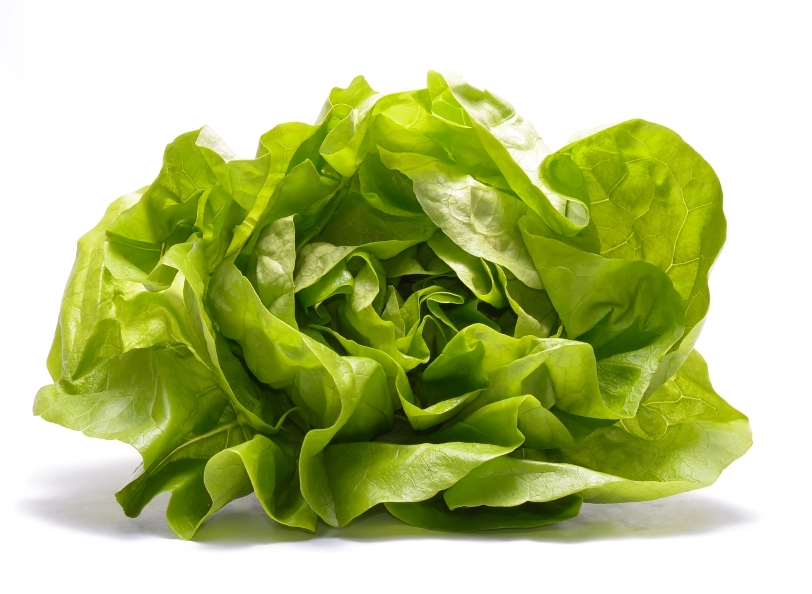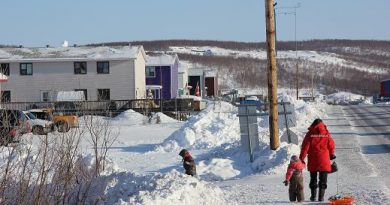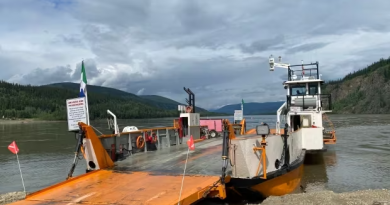‘Farm in a box’ offers year-round Alaska crops

An Anchorage startup company has found a new use for the refrigerated container vans that once brought perishable items to Alaska, repurposing them to create transportable hydroponic gardens that can produce leafy greens year-round in northern communities.
The co-founders of Vertical Harvest Hydroponics hope the heavily insulated 40-foot units, resembling trailer homes without windows, will help fill a commercial niche in a state where nearly all lettuce, kale and herbs are imported, sometimes arriving at remote locations rotten and weeks old.
“Right now, we cannot grow year-round in Alaska but this gives you the ability to do that 365 days a year,” said Linda Janes, one of the company’s three co-founders.
The self-contained units, outfitted with heating systems, shelves and electricity to support LED growing lights, Janes said, can produce 1,800 plants at a time in mineral-rich water, without soil — the definition of hydroponics.
The units can be heated in a variety of ways, including with propane, natural gas, wood chips or solar power.
“This is turnkey,” Janes said. “You drag it to a location on treated lumber, plug it in and start growing.”
The company has sold two units in Anchorage, with the newest models starting at $100,000, she said.
Use for rural communities
The farm-in-a-box concept seems particularly useful in off-road villages where store items arrive by plane or barge, boosting prices and making fresh food a rarity.
But the units could face economic challenges in many rural communities with steep electric costs and small populations — as well as shipping expenses that add several thousand dollars to the cost of imported container boxes.
Danny Consenstein, head of the U.S. Department of Agriculture’s farm service agency in Alaska, said he’s toured one of the trailers in Anchorage.
He said he thinks they can be part of a rising trend toward locally produced foods in Alaska, a movement that includes greenhouses and crop tunnels that help extend traditional summer growing seasons.
Rural residents in particular want less costly food and an alternative to diets that include too much junk food and soda pop, he said. The diets are blamed for high rates of diabetes, cardiovascular disease and some forms of cancer.
“I’ve seen $10 heads of lettuce in stores, so I think the economics of this project will work,” he said, adding that the agency is willing to provide loans for qualified applicants interested in acquiring a unit.
“The benefits to rural economies are you keep dollars there, you’re putting people to work and you’ll see healthier food choices in places that don’t often have that choice,” he said.
Housing uses
Kevin Runyan, vice president of Container Specialties of Alaska, has been working with Vertical Harvest Hydroponics to modify the cargo units, including removing refrigeration systems and adding heating equipment and moisture-proof wiring, he said.
Runyan, who buys old containers as shipping companies replace them with new ones, said the insulation doesn’t need beefing up. It’s already equivalent to that in homes with a five-star energy rating.
In fact, some Alaskans have turned the containers into housing. Runyan’s company has recycled them into backcountry cabins, sleeping quarters on North Slope oil fields, even a response center near Valdez where sick seals were treated following the 1989 Exxon Valdez oil spill, he said.
Vertical Harvest’s effort to sell them for hydroponic farming is a novel approach, he said.
“It’s a great idea and we’re trying to help them out as much as we can,” Runyan said. “Everyone is trying to get onto hydroponics to grow pot, but this will be way more beneficial to everyone.”
The problem of getting fresh food to the Arctic
Vertical Harvest got its start more than a year ago when Cameron Willingham, a former horticulture research professional at the University of Alaska Fairbanks, met Dan Perpich, a former Army training officer based at Fort Wainwright.
The two got to talking about the lack of fresh food in the Arctic.
Perpich had once seen brown lettuce selling for $18 a head during military training in Canada. Willingham had once worked at the Alaska Commercial Co. warehouse in Anchorage and witnessed large amounts of processed food bound for villages.
With advancements in LED helping spur so-called indoor “vertical farms” around the country, the two saw promise in the Arctic and co-founded the company with Janes.
“We saw a huge opportunity with controlled-environment agriculture, especially applied to rural Alaska,” Willingham said.
The company’s funding has come solely from the co-founders, not from grants or loans, Janes said.
Clinton White has purchased one of the growing systems. A vice president at Craig Taylor Equipment Co. in Anchorage, which sells John Deere equipment in Alaska, he has long wanted to try farming. He founded Greatland Greens last fall, and hopes to sell lettuce, kale, herbs and other items to stores and restaurants.
In the coming weeks, he plans to grow his first batches in hopes of perfecting the quality before approaching potential buyers with a product.
Evaluating demand
Alaska has room for more than one hydroponic operation selling produce, he said. One such business, called Alaska Natural Organics, recently began selling living basil in Anchorage stores.
“In Alaska, we import about 95 percent of our food, so I think there’s space for other people,” White said.
Kyle Belleque said he’s thinking about buying a unit and shipping it to Dillingham. He said he created the Belleque Family Farm not long ago but found it difficult to grow enough food to continue operating commercially.
The hydroponic operation could lower labor costs and boost the growing season, he said.
“The biggest problem is it’s such a short growing season out here,” he said. “But stretching it out to 12 months would be awfully helpful.”
Getting a feel for potential demand is difficult, since local, fresh produce has never been available year-round in the Southwest Alaska community of 2,400. But he believes residents will be happy to replace artificially preserved “lettuce dipped in chemicals” to support a local grower offering tastier, healthier choices.
“If we can do anything for ourselves, without flying in jets and barges, then we should do it,” he said.
Related stories from around the North:
Canada: Addressing northern food insecurity, Blog by Heather Exner-Pirot
Norway: The food crisis in the Far North, Barrents Observer
Sweden: Demand ups Sweden’s reindeer meat prices, Radio Sweden
United States: Food insecurity in Alaska, Alaska Dispatch News



